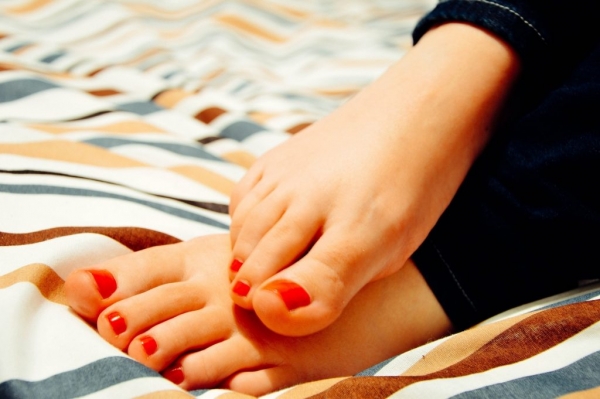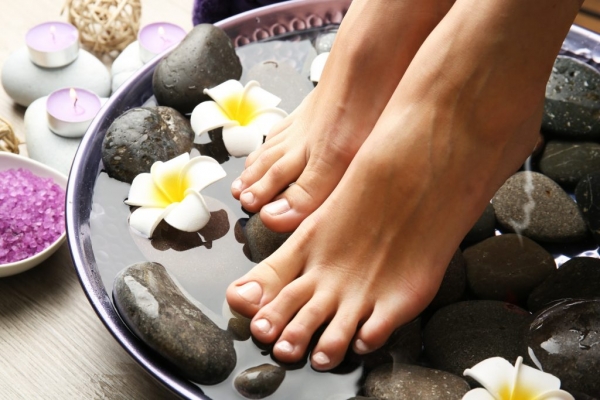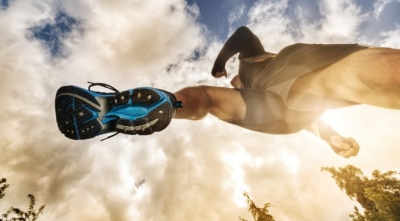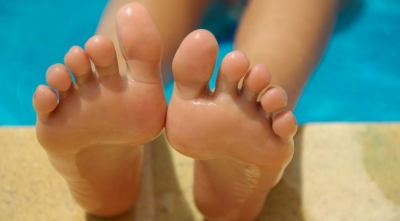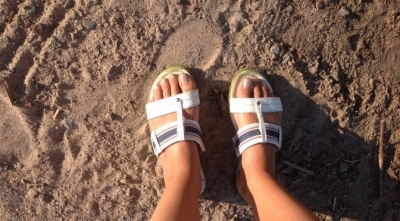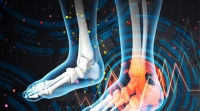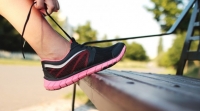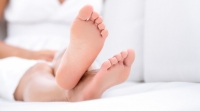Connect With Us
Blogs

Health Tips (46)
How To Treat Plantar Warts At Home
A plantar wart is one of just a few soft tissue conditions, which can be very painful. It is also very common, and can be treated at home with common household items or over-the-counter products.
Treating Plantar Warts: Causes and Symptoms
Plantar warts are caused by a virus which invades the skin through small or even invisible cuts and abrasions. It is most often contracted while walking barefoot on dirty surfaces or littered areas.
Communal bathing facilities and other warm, moist environments are also breeding grounds for the virus.
Plantar warts are found on the bottom of the feet. They tend to be hard and flat, with a rough surface and defined boundaries. They are often gray or brown (colors may vary) with one or more pinpoints of black. Left untreated, the warts may grow to an inch or more and may even spread into clusters (often called mosaic warts).
These warts are very resistant to treatment, and may even return after healing; but some have been known to disappear on their own. Though warts may be painful on weight-bearing areas of the feet (e.g. the ball of the foot or the heel), most warts are harmless.
Read more about warts and how to identify them here.
Plantar Wart Treatments: Home remedies
Peeling Medicine
Nonprescription wart removal methods typically come as a patch or liquid. The directions usually tell patients to wash the affected area and soak it for 20 minutes. Gently remove the dead tissue with a pumice stone or emery board, then apply the solution or patch. Patches are typically changed every 48 hours, while liquid applications are applied twice a day. Results may not appear for several weeks.
Cryotherapy
You may be able to get this kind of treatment from the doctor . The doctor will trim the wart with a small knife. In rare cases, local anesthetic may be administered. Then, the doctor applies liquid nitrogen with a probe or cotton swab.
Duct Tape
For this method, cover the wart with silver duct tape for six days, then soak the wart in water. Remove the dead tissue with a pumice stone or emery board, and leave the wart exposed for 12 hours. Repeat this process until the wart is gone. Keep in mind that this method has seen mixed results at best.
You may want to discuss these methods with your doctor first. Most over-the-counter wart treatments will contain acids or chemicals which destroy skin cells. An expert hand will be able to destroy the abnormal skin cells without harming the surrounding healthy tissues. Patients with diabetes, cardiovascular diseases, or circulatory disorders should avoid self-treatment entirely.
Prevention
There are a few steps to take in order to prevent plantar warts from forming:
- Avoid direct contact with warts, including your own.
- Keep feet clean and dry, and change shoes and socks daily. This basic step is essential for preventing blisters and fungal infection as well.
- Wear shoes or sandals in areas where the wart virus thrives, such as communal showers, dirty areas, and swimming and pools.
- Don’t pick at the warts, as this may cause the virus to spread.
Reserve a different pumice stone or emery board for the warts, and another for healthy skin and nails. - Use a disposable emery board to avoid spreading the virus
Wash hands thoroughly after touching a wart. - Check children’s feet regularly.
When To See a Doctor
If you have a plantar wart and the treatments listed above haven’t been effective, you should see a doctor about other treatment options. Generally, it is always a good idea to see a doctor whenever there is a growth or eruption on the feet to ensure the correct diagnosis. Sometimes, what appears to be a wart may actually be a sign of cancer – for example, carcinoma or melanoma.
Ask the Experts
If you are concerned about a wart that won’t go away, schedule an appointment with Dr. Vikki or Dr. Connie today. For more foot care advice, contact the specialists at Superior Foot & Ankle Care Center.
How to Prevent Ingrown Toenails
While an ingrown toenail might happen to some people more than others due to hereditary factors, the fact is that an ingrown toenail can happen to anyone. Simply put, an ingrown toenail occurs when a nail grows into the flesh rather than over it, occurring most often in the big toe. The nail will irritate the skin, causing pain and even infection should it break into the skin. (An infected ingrown toenail will be red, swollen, hot, and painful). Ingrown toenails can become very painful conditions, but only because patients are often unaware of what the condition is and how it occurs.
Causes of Ingrown Toenails
A number of factors might cause an ingrown toenail:
- Wearing shoes that are too small. This is most common among teenagers.
- Hereditary traits like thick or curved nails will make a person more prone to ingrown toenails.
- Socks that are too short or tight will force the toes toward each other and encourage the nails to grow into the skin.
- Athletic people are also more prone to ingrown toenails. Excessive sweating makes the skin and nails softer and easier to split. Those split nails can easily puncture the skin.
- Trauma – such as stubbing, jamming, or dropping something on a toe – can contribute to the development of ingrown toenails.
- Active people who participate in activities like running, soccer, or ballet will need to be pay special attention to the signs of an ingrown nail.
- A common cause of ingrown toenails, improper nail trimming will encourage the skin to fold over the nail.
How to Treat an Ingrown Toenail
If caught in its early stages, an ingrown toenail may be prevented or even cured by taking the following steps:
- Soak the affected toe in water for 10 minutes. This will soften the folds of skin around the nail.
- Using a Q-tip, push the skin fold over the ingrown nail down and away from the nail. Start at the root of the nail, then move toward the end of the nail.
- Repeat every day for a few weeks and allow the nail to grow.
- Once the nail has grown forward far enough, place a tiny piece of cotton wool or dental floss under it. This will prevent the nail from growing into the skin. Change the wool or floss every day after soaking the foot.
- Continue to let the nail grow forward until it is over the end of the toe. Cut the nail straight across – not rounded off at the ends.
Generally, persistent and troublesome symptoms should be brought to a doctor’s attention. The situation becomes urgent if the patient has diabetes or a poor immune system, since the infections must be treated immediately.
Patients with diabetic neuropathy, peripheral arterial disease, or those who have otherwise lost the nerves or feeling in their feet should see a doctor ASAP.
Additionally, patients that take are on chemotherapy or any immunosuppressant medications must see a doctor immediately.
These conditions make it difficult to sense problems like deep infections, requiring monitoring and assessment from a podiatrist.
Preventing Ingrown Toenails
- Cut nails straight across, being especially careful not to cut too short or low at the sides. The corners of the nails should be visible above the skin. Cutting nails after a shower is easiest, since the nails are softer.
- People who see a pedicurist should ensure that they are trimming straight across.
- Patients with poor blood flow may not be able to trim their nails on their own, and should therefore see a podiatrist regularly for trimming.
- Toenails should be kept even with the tips of the toes. Trim too short, and pressure from shoes might lead the nail into the tissue.
- Wear shoes that fit properly. People with nerve problems or chronic ingrown toenails may need to visit a shoe store that specializes in people with foot problems.
- Wear protective footwear, especially in a warehouse or other environment where foot injuries are common.
Keep feet clean and dry, and air them out as much as possible. - Avoid tight shoes. Use cotton socks and not synthetic.
- Diabetics must take extra care when cutting nails, and pay special attention for the symptoms of ingrown toenails.
- Cut the nails straight across, following the shape of the toe. Do not cut too low at the sides.
- Gently file away sharp edges.
- See a podiatrist for nail trimming if loss of feeling in the feet occurs.
- Patients with poor vision should see a chiropodist to trim their nails.
For more information about feet and nails, or to schedule an appointment, please visit Dr. Vikki.
How to Prevent Smelly Feet
Smelly feet (eccrine bromhidrosis) is a common condition which many people experience, in particular pregnant women, teens, the elderly, heart disease sufferers, diabetics, and people who are stressed. But did you know that there are many different ways to treat it?
The reason why feet get so smelly is because they have around half a million sweat glands excreting sweat into socks and shoes. With no other place to go, most of the sweat remains on the feet, creating a warm, moist environment where bacteria and fungi thrive.
The solution is simple: by taking better control of your hygiene, you can minimize the incidence of smelly feet significantly.
Wash Your Feet Thoroughly
While many people mistakenly believe that a simple shower is sufficient, the fact is that most people do not clean their feet properly. Proper foot hygiene requires a daily, thorough cleansing with antibacterial soap.
Drying the feet is just as important, since moisture tends to collect in-between the toes.
Use a Foot Antiperspirant
If thorough cleansing isn’t enough, apply an over-the-counter athlete’s foot spray or powder to your shoes and feet. Even your underarm deodorant will work just as well, provided that it contains aluminum chloride hexahydrate, which is a chemical that prevents excessive sweating.
There are antiperspirants designed specifically for feet, from brands such as Klima and Sweatblock. There is no downside to giving this a try, unless you are walking on a slippery surface.
Home Remedies
Certain home remedies have gained the support of podiatrists. Bathing your feet in either salt, tea, or vinegar are effective ways to dry out your feet and prevent bacteria from growing.
Salt and vinegar both absorb moisture from the skin. Tea closes your pores and also acts as a natural antibiotic.
For a saltwater bath, dissolve ½-1 cup of kosher salt in a tub or large bowl. Soak for 20 minutes, and repeat every day for two weeks.
Vinegar baths require one part vinegar and two parts water in a tub or large bowl. Feet should be soaked 30 minutes a day for one week.
Two black tea bags for every pint of water should be added for a tea bath. Let the water boil with the tea bags for 15 minutes, then add 2 quarts of cool water. Pour this solution into a tub or a large bowl. Soak for 30 minutes, and repeat daily for one week.
Socks and Shoes
Choosing breathable footwear is one of the best ways to prevent future incidence of smelly feet.
Breathable socks and shoes allow moisture to evaporate, making it more difficult for bacteria to grow. Generally, the socks and shoes you buy should be made from natural materials.
Unlike synthetic materials like polyester and nylon, socks made from natural materials like cotton and wool will provide more ventilation.
As for shoes, leather and canvas are two of the most breathable materials. Insoles made with activated charcoal will act as further protection against stinky feet.
Never wear your shoes without socks. This will allow sweat and bacteria to accumulate, in addition to the buildup of dead skin cells, dirt, oils, mold, and fungus.
Use Odor-Killing Shoe Products
There are a wide variety of anti-odor products available for your shoes. Choosing between the options is largely a matter of your individual preferences and needs. Dr. Scholl’s and Kiwi are two of the more popular brands for this purpose.
Otherwise, common kitchen and bathroom products such as baking powder, corn starch, baby powder, and talcum powder may be enough to suit your needs.
When To See a Doctor
In rare cases, foot odor can be so foul or persistent that a visit to the doctor is warranted. You will only need to do this if the steps above have not been sufficient.
Smelly feet are sometimes a sign of a larger medical problem, especially if you have an immune system deficiency.
If smelly feet have been plaguing you even after practicing proper hygiene, check for cuts or wounds in the skin between the toes, and for signs of infection like redness and swelling.
If you are diabetic, be especially attentive to your foot odor, since infection progresses much faster.
Consult the Experts
For the best in foot care, schedule an appointment with Dr. Vikki or Dr. Connie today.
For this and all other related questions and concerns, consult the specialists at Superior Foot & Ankle Care Center.
Choosing the Right Running Shoes | Superior Foot and Ankle Care Center
devHow to Choose the Best Running Shoe for You
Whether you’re a running novice or an experienced veteran, picking out running shoes can be a daunting task. It can be tempting to just grab the best looking pair from a popular brand, but the right shoes are imperative in preventing running-related injuries. With so many options bragging a variety of different features and claiming to help with an assortment of problems, it’s hard to know which shoes are right for you. Fortunately, there are a number of things you can keep in mind to help you make the right decision.
Shoe Buying Myths
To start, there are a number of myths surrounding running shoes. It’s important to not buy into them in order to find the best shoe for you.
There’s a Best Running Shoe
Many people choose a running shoe based on the popularity of a brand or shoe style, but everyone’s foot, running style, and needs are different. There’s no running shoe that is best for all, or even most, people. That’s why there are so many options available.
I’ve Found a Shoe I Like, so I Don’t Need to Try on Shoes Again
The same model of shoe won’t work for you forever. Models change slightly or even dramatically between years, as do your needs. Your running form can change over time due to injuries or strengthening and weakening muscles. Changes in your goals, routine, or running surface can also affect your needs. There’s also evidence that shows that alternating between different models from workout to workout can help to strengthen your ankle and foot.
The Right Shoe Will Help My Times
Your shoe won’t make you faster, but it can make you feel faster as your gait becomes more comfortable and natural. However, wear in the sole can slow you down and make you more prone to trips or falls as the shoes lose their grip. To prevent this, shoes should be replaced every 300 to 400 miles to prevent injury and ensure comfort.
Your Individual Needs
When shopping for running shoes, it’s helpful to determine your specific needs based on both the shape and size of your foot and your running style. Whenever you try on shoes, remember to bring any braces or inserts you need.
Shoe Size
When buying shoes, remember that size varies between brands and even between models within the same brand. The size you’ve worn in other shoes provide an estimate of the side you need, not a guarantee. Try on several different sizes to see what you like best. Laces should be snug and the ankle shouldn’t rub. You should have about a thumbnail’s space between your toe and the end of the box. (‘Barefoot’ style shoes are an exception. They should fit close to the toes, ‘like a glove.’) It’s helpful to try on shoes at the end of the day when they’ve swelled and are at their largest.
You should also remember that you don’t have to stick to the shoes in your gender’s section. Men with narrow feet may have luck with a women’s shoe while women with broad feet may have better luck with with a man’s shoe.
Arch Height
Like in any other shoes, having the proper support for your arch height in running shoes is important for ensuring comfort. Many running stores can help you determine your arch height, but you can also get some idea of your arch height at home using the ‘wet’ test.
Strike Location
When you foot hits the ground, it should land ankle first for the best possible form, but many people’s feet land farther forward on the foot. This can be corrected by the drop of the shoe, or the difference between the height of the toe and the height of the ankle of the shoe. A higher drop forces the foot to plant farther back.
Pronation
Pronation refers to the inward roll of the foot after the foot strikes the ground. Virtually everyone has some pronation, but there are shoes to stabilize over or under-pronation. For those who don’t need correction, minimalist or ‘barefoot’ shoes are options.
Superior Foot and Ankle Care Center
All of this information certainly provides guidance when shopping for running shoes, but what’s most important is that you find shoes that you like and makes you comfortable. If you overpronate but aren’t comfortable in any of the shoes for overpronation, not only will you be less likely to run, you may be more likely to hurt yourself, according to a 2015 study.
While finding the right shoes can be difficult, they are imperative to staying healthy while pursuing your running goals without injury. If you have difficulty finding the right pair, or suffer from a foot or ankle injury that makes running difficulty, the experts at Superior Foot and Ankle Care Center in Long Beach, California can provide you with the care and support you need to meet your goals. Contact us today to schedule an appointment and join our many satisfied customers.
Blisters are common, especially for those who do a lot of walking or running. However, many people don’t know how to care for their blisters properly. Here are some tips for healing any blisters you may already have, and how to avoid new ones from forming:
When You Can Remove a Blister
When blisters are small and do not show any signs of infection, it is perfectly okay to pop them. Simply disinfect the area and drain before the blister can become infected. Afterward, treat the wound with antibiotic ointment.
To safely pop your blister, you should:
- Thoroughly wash your hands and the blister with water and antibacterial soap. Then cleanse the blister with rubbing alcohol or iodine.
- Gently rub your blister to see if it will pop on its own. If it doesn’t, soak your feet in warm water for 30 minutes. Then try popping it again.
- Cover the wound with antibiotic ointment and a bandage.
When You it Shouldn’t Be Remove
If your blister shows signs of redness, swelling, soreness, pus, or even pain, do not pop it. All of these symptoms may indicate that you have a serious infection, or that your blister is actually a foot ulcer. Both of these conditions require the attention of a podiatrist to be treated properly. Foot ulcers, particularly for diabetics, can become gangrenous and result in the need for amputation. If you are experiencing any of these symptoms, or if you suspect that you have a foot ulcer, seek medical attention immediately.
Blister Treatment
Blisters are often sore while they are healing, so be sure to keep your feet comfortable. For example, put extra padding on the affected area, or use a healing ointment that also provides pain relief.
Blister Prevention
In order to prevent future blisters, make sure that you always wear shoes that fit properly. In addition, avoid going sock-less while wearing shoes like sneakers or boots, particularly if you’re going to be walking for a while. When you do wear socks, be sure that they are thick and provide extra padding in sensitive area like the back of the heel. Cotton socks absorb moisture, causing blisters when the wet socks rub against your feet.
People with foot abnormalities, such as bunions, often develop blisters. If you are constantly suffering from blistering feet, consult your foot care professional.
For more foot care tips and tricks, consult the experts at Superior Foot & Ankle Care Center with all of your podiatric questions and concerns.
Summer can be hard on your feet, making proper foot protection a priority. Here are 15 simple steps to healthy, beautiful feet all year round:
Use Sunscreen
Protect your feet the from harsh UV rays on sunny summer days. Apply sunscreen with SPF 15 or higher to protect your skin from cancer and premature aging. Also, remember to reapply your sunscreen after swimming or sweating, even if the sunscreen claims to be waterproof.
Avoid Walking Barefoot
Walking barefoot is always dangerous, but the intense summer heat increases your risk of sustaining foot injuries. It also puts you at risk of developing plantar warts, ringworm, athlete’s foot, and other infections on the soles of your feet.
Wash Feet
Wash your feet with warm water after wading in lakes, ponds, and other stagnant bodies of water. Still water breeds bacteria, leaving you vulnerable to infection.
Treat Yourself to a Pedicure
Treating yourself to regular pedicures will ensure that both your nails and feet look their best in your chic summer styles.
Stay Hydrated
Staying properly hydrated during the hot summer months will prevent swollen feet. Proper hydration also improves your circulation, which in turn helps you fight infection.
Moisturize
Your feet are drier in the summer since you’re no longer wearing socks. Apply plenty of moisturizer in the morning after your shower to lock-in the moisture. For the best results, reapply before bed.
Wear The Right Socks
Acrylic and synthetic blend socks like CoolMax work the best to wick perspiration, preventing fungal infection. Socks that do not wick perspiration, such as those made from 100% cotton, increase your risk of developing blisters.
Prevent Blisters
Sandals can often cause blisters when they rub against bare feet. If you feel a blister developing, use extra padding such as liquid bandages to protect the affected area. If a blister does develop, be sure to treat it with antibiotic ointment after it pops.
Keep Shoes and Socks Dry
If your shoes or socks get wet, remove them. Wearing wet footwear leaves you vulnerable to developing fungal infections and blisters. Always bring a spare pair of socks and shoes if your feet could potentially get soaked.
The Right Shoes for The Right Occasion
Whether you’re going camping, hiking, boating, or running, it’s always best to wear footwear designed for the activity. Wearing improper footwear during strenuous activity can result in serious injury.
Air Out Feet
Avoid wearing closed-toe shoes and reach for sandals to let your feet breathe. If closed-toe shoes are required, be sure to take them off periodically in order to keep your feet from sweating.
Evaluate Your Flip-Flops
Flip-flops tend to cause sore feet, but that doesn’t mean that you have to avoid them. Be sure to choose flip-flops with extra padding, and avoid walking long distances in them.
Add Cushioning to Shoes.
Many summer shoes do not provide the proper cushioning to keep your feet protected and pain-free. Due to this, you should replace the cushioning in your shoes whenever possible. There are many over-the-counter insoles that will add extra cushioning on the cheap.
Inspect Old Shoes.
Old, worn-out shoes can cause blisters and other foot injuries. Be sure to assess the condition of your summer shoes, and throw away any questionable pairs.
Fore more foot care tips and inspiration, contact the experts at Superior Foot & Ankle Care Center for all of your podiatric needs.
Expecting mothers often experience swollen legs, feet, and ankles during and immediately after their pregnancies. This is due to the extra weight and stress on the feet, which causes pain after long periods of walking or standing.
For some mothers the extra weight on their feet may even cause their arches to fall, causing extreme pain. When the arches of your feet fall, you may begin to over-pronate, or turn in abnormally when walking. Over-pronation can stretch the plantar fascia, which is the tissue lining the bottom of the feet, causing a painful inflammation known as plantar fasciitis.
Edema, or swollen feet, is another common issue that expecting mothers face.
Both of these foot issues, especially when experienced together, make it extremely difficult to walk or stand for a long time. Therefore, it is vital for expecting mothers with pre-existing foot issues to discuss how their pregnancy will affect their feet with a podiatrist.
Below are a few tips for mothers to treat swollen and aching feet:
Always wear comfortable and supportive footwear
For added comfort and support, try using gel insoles.
Exercise regularly
The more you move, the more blood moves out of your legs into the rest of your body. If you find most exercise painful, try using a stationary bike or an elliptical trainer.
Drink plenty of water; avoid salt and caffeine
Staying properly hydrated helps your body flush its system of extra fluids. Therefore, drinking lots of water will help you relieve your swollen feet and ankles. Avoid consuming salt and caffeine because they cause your body to retain fluids.
Elevate and ice your feet
Elevating and icing your feet helps relieve the pain and tension associated with swollen feet and ankles.
Soak feet in warm water
Soaking your feet can relieve their pain and tension. In addition, the warm water can stimulate blood flow and reduce your swelling.
Get a foot massage
A massage is an excellent way to alleviate pain and reduce swelling. Massages stimulate blood flow and improve circulation, providing the muscles and tissues with the nourishment they need to heal. Improved circulation also reduces swelling.
Apply pain relief ointments
There are many over-the-counter pain relief ointments specially formulated for expecting mothers. These ointments help relieve pain and tension, especially from the bottoms of your feet. While these ointments are designed for pregnant women, it is best to speak to a healthcare professional before you begin using them.
Know your limits
If you find that your feet are becoming extraordinarily swollen after you walk, it is best to take breaks and to elevate your feet whenever possible.
Motherhood is beautiful, and your foot pain shouldn’t ruin the experience. Schedule a consultation with Dr. Vikki today for personalized foot care and relief.
In some cases, foot issues can be corrected through a number of treatment methods. However, if pain and discomfort when you run, stand or walk is consistent, then foot surgery is necessary. Foot surgery can correct your feet’s physical deformities and, therefore, alleviate any of the discomfort and pain that you are feeling. Here’s a list of common foot issues and deformities that require surgical removal to relieve pain.
Bunions
Bunions are a common foot deformity that is characterized by an enlargement of the bones and tissue around the big toe. Like most foot deformities bunions are hereditary. This enlarged area is prone to becoming swollen, inflamed and makes walking incredibly painful and difficult. When conservative care failed to alleviate these issues, it may be best to have them surgically corrected. Your foot care professional will be able to instruct you as to which surgical procedure will be best for you after running some tests and taking x-rays.
Hammertoes
Hammertoes are characterized by a curvature of the big toe, which often affects the tendons and nerves around it as well. Because of the buckling of the toes, footwear can cause an immense amount of pain and discomfort. I is not uncommon for those who suffer from hammertoes to also have a large number of corns and calluses on the affected area due to their deformity rubbing against their footwear. A surgical procedure can realign your toe bones and alleviate the pain and discomfort associated with hammertoes.
Bone Spurs
Bone spurs are overgrowths of bones that results in trauma and pressure to the tendons and ligaments. Pain and discomfort can also be associated with bone spurs depending upon where they are located. For example, if the bone spurs are located under your toenail this may cause a toenail deformity and making it difficult to walk and painful to wear shoes. What surgical procedure is needed to correct bone spurs depend on their size and location, so be sure to consult your Foot Care Professionals to decide which procedure is best for you.
Bunionette or Tailor’s Bunion
A Bunionette is protuberance of bone on the outside of the foot behind firth or smallest toe. Many factors can cause this issues such as heredity, the way you walk and trauma to name a few. They can become inflamed and swollen, particularly if they rub against your footwear. Much like bunions, if conservative care does not alleviate the pain and discomfort associated with this deformity, it may be best to have them surgically corrected.
Neuroma
Irritation of the nerves may cause them to become swollen and inflamed and result in an enlargement of a nerve segments, this is called Neuroma. This nerve segment is often found between the third and fourth toe and can be quite painful particularly when walking. People came develop Neuroma for a number of reasons to include wearing high heel shoes and having an abnormal bone structure. This deformity can cause pain and burning for particularly after walking for a long time. If this deformity has greatly impeded your quality of life, it’s best to speakers foot care professional about a surgical solution.
Now that you know a few examples of when foot surgery is absolutely necessary hopefully it helps you decide if surgery is the right choice for you. Remember foot pain is not normal and having healthy, pain-free feet are essential for living a well-rounded life. Our expert team would be happy to discuss any questions you may have about the procedure. To schedule a consultation visit doctorvikki.com.
The Special Olympics Healthy Athletes program began as an effort to enhance the sports experience at the event, and improve well-being for every athlete. The Fit Feet initiative became a part of this endeavor in 2003. We here at the Superior Foot and Ankle Care Center are proud to take part in the screenings for the Special Olympics to ensure that the athletes have the proper socks, shoes, and the special equipment they need to compete to the best of their abilities and stay healthy.
Here is a glimpse at some of the advice that we give to the Special Olympians. Even if you’re not an athlete, proper foot care is important for your overall health and comfort. Make sure that you understand the steps you need to take for optimal foot health.
General Care
Inspect your feet regularly, checking for calluses, blisters, bunions, discolored nails, and any other potential problems.
Always wear shoes or sandals to protect your feet. Don’t settle for any shoes: make sure that they are appropriate for the activity at hand. For example, wear running shoes and moisture-wicking socks for running, basketball shoes for basketball, and sandals for the beach. Make sure that your shoes are clean inside and fit well. Buy new shoes when the cushioning has run out, and check that you can wiggle your toes in the new pair. Runners should replace their shoes every 250-500 miles, at which point the shoes begin to lose shock absorption.
Skin Care
Take care to wash your feet with soap and water, and dry them thoroughly thereafter. If your feet retain too much moisture from sweat or from the shower, painful blisters may develop. Always wear clean socks to prevent foot odor.
Foot powder is an excellent way to protect your feet from damage and discomfort. Foot powder absorbs excess moisture, provides itch relief, soothes irritated skin, and fights odor-causing bacteria. To prevent skin cracking and calluses, moisturize with lotion regularly.
If you develop a blister, never pop it. Wash the affected area, apply antiseptic, then use a bandage to prevent infection.
If you experience soreness, soak your feet in Epsom salts. These salts are also an effective way to soothe muscle aches, sun burns, and even relieve stress.
Nail Care
Nails should be trimmed weekly to keep them healthy and strong. Long nails may break and attract harmful bacteria. Always cut nails straight across using either scissors or clippers. Be careful not to cut too short, or you may develop an ingrown nail. Nails are designed to protect from trauma: cut your nails too short, and you will experience a lot of discomfort, and possibly even injury. Do not pick at your toenails with your fingers, as this may damage them.
Check your feet for discolored or thick nails. If you suspect a problem, schedule an appointment right away.
Remember that your feet need proper hygiene and care, just like any other part of your body. Whether or not you’re an Olympian in training, your feet deserve the same level of treatment. Contact us today with any questions or concerns, and schedule an appointment for your best foot health.
Feet are often taken for granted, despite their critical role in the human body: they support our weight and keep us on the move, so that we can go about our busy daily lives. However, the anatomy of the foot is intricately complex, and the result of any structural complications can be very painful. This is the case with fallen arches.
What Are Fallen Arches?
The arches of the foot play an integral part in weight-bearing, absorbing pressure, and aiding in movement and stability. If the tendons and muscles in the foot weaken, the arches can collapse.
The weakening of the tendons that causes fallen arches can occur due to factors such as aging, genetics, posterior tibial tendon dysfunction, or injuries to the feet. Other contributing factors include obesity, diabetes, arthritis, and involvement in high-impact sports.
Fallen arches are an adult flatfoot condition, where the soles of the feet almost touch the ground completely while standing. Another visible indication of fallen arches is that the feet become turned outward. This condition is often painful and uncomfortable. If your arches have fallen, you may also experience symptoms such as:
- Ankle pain
- Heel pain
- Pain in your hips or knees
- Swelling around the ankle
- Pain or fatigue when walking or standing up
Treatment Options
Thankfully, there are many different methods to treating fallen arches and relieving the pain that they cause. In some cases, conservative treatment options are the right fit; in more severe situations, surgery may be needed. It really comes down to consulting with a podiatrist to best ensure that your individual needs are met, and that your flatfoot condition is diagnosed and treated properly.
For less severe cases, the RICE method (rest, ice, compression, and elevation) may be used to ease the discomfort and reduce the inflammation. Even the simplest changes such as wearing orthotics or more supportive shoes have been known to provide pain relief.
Stretching exercises which strengthen the muscles are another approach to fallen arches treatment. Your foot doctor or physical therapist may recommend exercises that include actions such as lifting small objects with your toes in order to contract the arch.
Boots, braces, and casts are other common approaches to treatment. Inflammatory medications are also prescribed to provide pain relief.
Finding a Podiatrist Who Cares
Unfortunately, fallen arches are not taken as seriously as they should be. At Superior Foot & Ankle Care Center, our expert podiatrists view surgery as a last resort and support instilling patient education, preventive methods, and proper foot health as the primary course of action. The care we offer is rooted in extensive podiatric knowledge, as well as our dedicated and sincere concern for our patients.
Fallen arches may have gotten your arches down, but we will help you take a step in the right direction to achieving happier, healthier feet. Contact us today for an appointment at our Long Beach office.
More...
If you have sustained a sprain or a fracture to your ankle, it is important to let it heal properly in order to avoid permanent damage. Ankle sprains are incredibly common: over 25,000 people suffer them every day. A sprain occurs when one or more ligaments on the outside of your ankle are pulled or torn. As it is hard to differentiate a sprain from a fracture, it is imperative to seek medical attention so that your ankle can be x-rayed. Once your injury has been diagnosed, you’ll be able to give it the care it needs in order for it to heal properly. Here are some tips for properly caring for your ankle injury to ensure that it heals correctly:
For a Sprain
Depending upon how serious the sprain is, the sprain can be classified as grade 1, 2, or 3. The best way to treat a sprain is to utilize the R.I.C.E. method: rest, ice, compression, and elevation. For a grade 1 sprain, you should rest your ankle by not walking on it as much as possible, only putting minimal weight on it. In many cases, an ankle brace will be given in order to help reduce the swelling and discomfort of a sprain, which may make it easier to put some weight on it if need be. However, if it is too difficult to bear weight, you may be given crutches. You can apply ice to help relieve the pain and swelling. When you ice your ankle, make sure that there is a barrier between the ice and your skin, such as a pillowcase or a towel. You shouldn’t ice your ankle for more than 20 minutes in order to avoid frostbite. Compression can help control the swelling, as well as provide your ankle with some support. Finally, you should elevate your ankle as much as possible by reclining and propping it up. It’s best to elevate your ankle either above your waist or your heart for optimal recovery.
With a grade 2 sprain, you would follow the same steps. While the grade 1 may take a week to heal, a grade 2 may take up to a month. Grade 3 sprains are rare and may require casting or surgery.
For a Fracture
If you fracture your ankle, your treatment will involve casting, taping, wrapping, or booting, depending upon the type and severity of the fracture. Much like a sprain, it is important to rest and elevate a fractured ankle. A fracture usually takes 4 to 8 weeks to heal. Once the cast comes off, you may have to follow the R.I.C.E. method until you regain strength in your ankle.
Rehabilitating Your Ankle
If you have a sprained or fractured ankle, you need to properly rehabilitate it in order to regain your full strength and flexibility. The first phase of rehabilitation is the R.I.C.E. method. The second phase is helping your ankle regain flexibility, strength, and range of motion by walking and putting weight on it. The last phase is exercising your ankle in order to strengthen the muscles and ligaments further.
Be sure to follow these steps to help your ankle heal properly. If you have any questions or concerns about your ankle injury, contact us today to schedule an appointment.
Dealing with a toenail fungal infection can be both difficult and unpleasant. When fungi attacks the nails, it can leave them yellowed, thick, split, and damaged. It can also leave you ditching your favorite pair of flip flops, or even hiding your feet in embarrassment when around other people. But aesthetics aside, nail fungus can have other, potential, effects that are even more concerning. Eventually, it’s possible for walking to become painful, or for the infection to spread. At which point, removing the nail might be necessary.
Unfortunately, this common condition doesn’t go way on its own. Instead, its capacity to get worse, and to impact your health, reveals that treatment, and preventative measures, are the keys to stopping a toenail infection from worsening.
The Fight Against Fungus
While you may have picked up the fungus from something as simple strolling around the pool barefoot, it’s not so simple to treat or eliminate it. This is one reason why early detection and treatment always remains the preferred route. That being said, steps towards getting rid of the infection can go in several directions.
You can’t deny that over the counter creams and topical applications offer convenience. Yes, it’s pretty natural to like the idea of purchasing a solution at your nearby drugstore. However, many of these products lack that ability to provide effective treatment is less reliable because many don’t penetrate deep enough to fully eradicate the fungus. The same can be said for plenty of home remedies. Seeking treatment from a professional foot doctor is often the best way to go and fight the good fight against fungus. A podiatrist will evaluate your condition and then based on the severity of the infection, go over your options.
Sometimes, a topical medication is a part of the plan. In other cases, these treatment methods may be recommended:
- The removal of thicker portions of the nail to provide pain relief (Debridement)
- Getting rid of the fungus using laser treatments
- Oral medications
Preventive Steps For Fungus-Free Feet
Even if you’ve kicked a fungal infection through treatment, it can come back. In order to keep it from returning and keep your feet healthy, here are several important steps to follow:
- Keep your feet clean: Wash them regularly with soap and water, then dry them thoroughly
- Keep your nails trimmed and make sure that toenail clippers, and grooming tools, are sanitized before using them.
- Wear clean shoes that are made of breathable materials
- Make sure to change your socks if they are dirty or damp
- Put on shower shoes in public areas, like a gym locker room or pool shower area.
Discovering Your Treatment Options
Toenail fungus may seem like a relatively small issue, but its capacity to get in between you, your lifestyle, and your foot health, is greater than you may realize. At Superior Foot & Ankle Care Center, we use our experience and knowledge to help patients with all kinds of foot-related problems, from the big to the seemingly small.
If you are dealing with nail fungus or another foot issue, please call us at 562-420-9800, today, or request an appointment at our Long Beach office. This is the first step to determining which course of treatment is right for you and what we can do to help you achieve happier, healthier feet.
Athletes are busy people. Whether they’re students balancing homework and extracurricular activities, or 9-5 workers trying to stay in shape in the evenings, athletes only have limited time for everything else. Focus on diet, exercise, and responsibilities, foot health is one of the last things on an athlete’s list of concerns. If you or someone in your family leads an active lifestyle, make sure they’re taking the time to take heed of the following foot care tips.
Shoes
If you’re devoted to a particular sport, you probably have a great pair of sport-specific shoes already. If for some reason you don’t, or you’re planning to start playing a new sport regularly, make sure that you get a specialized pair, soon. Basketball shoes, for example, have a very particular type of cushioning designed for rapid changes in direction and hard landings. If your shoes don’t fit well or aren’t designed for the activity, you could be risking injury.
When looking for shoes, shop in the afternoon or later, when your feet swell to their largest size. And one more thing: shoes tend to lose shock absorption between 250-500 miles. Runners who go for 25 miles every week will need new shoes, every 2.5-5 months.
Socks
Any old pair of socks might seem to do the trick, but believe it or not, those fancy Nike or Underarmor logo socks really do have a purpose. If your socks aren’t made with moisture-wicking fabric, the fabric will retain moisture for too long and may cause blisters.
College students, stay on top of your laundry: if you don’t change your socks often, you could develop foot odor.
Blisters, and Calluses
Speaking of blisters, don’t ever pop them. If they happen to pop, wash the area, apply antiseptic, then apply a bandage.
As for calluses, talk to your doctor before making a decision. Don’t try to remove them on your own, even if you have an over-the-counter product.
Toenails
Make sure toenails are trimmed to avoid in-grown nails. Cut the nails straight across, but leave them slightly longer at the end of each toe. Watch out if they turn black or blue; it could be a sign of blood underneath the nail, or possibly a condition like melanoma or an infection.
That should cover most (if not all) potential foot problems. If you take nothing else from this article, remember to practice proper hygiene, and use proper sports shoes and socks.
Feel free to contact us you have any further questions and concerns about your foot health. For a consultation, call Superior Foot & Ankle Care Center, at 562-420-9800, to set up an appointment today.
Diabetics, generally, have a lot of tasks on their daily agenda. In order to stay healthy and control their disease they go through routines that include monitoring blood sugar levels, eating a balanced diet, exercising, and sticking to a medication plan. Besides all of that, there is another critical thing they must do: pay attention to their feet.
The undeniable importance of diabetic foot care stems from the effects the disease can have on the body. Nerve damage caused by increased blood sugar levels can result in a loss of feeling in the feet. When dealing with another affect of poor circulation, a dangerous combination is formed. Cuts and blisters that would normally be noticed, can then go unfelt. If left untreated, an infection can set in due to the lack of blood flow and ability to properly heal.
Refraining taking the necessary steps to actively care for your feet, what may start as a minor issue can develop into a seriously situation, one that may lead to hospitalization and a possible an amputation.
Five Essential Foot Care Tips
Check Feet on a Daily Basis: This may seem simple, but it requires a certain level of dedication and diligence. Diabetics should inspect their feet for things like corns, infected toenails, areas of redness, and calluses. Through this self-assessment, early diagnosis is possible and further complications can be prevented.
Don’t Go Bare foot: Protect your feet from potential injuries such as cuts and burns by wearing shoes and socks. On the same note, shoes should be supportive, cushioned, and fit properly.
Encourage Blood Flow: Each day, those with diabetes should move their toes and ankles around to aid in proper circulation. They should also walk and stand whenever possible. Sitting with crossed legs should be avoided, and smoking cigarettes should be stopped, as it can diminish blood flow.
Maintain Properly Groomed Feet: To lessen the risk of infection, feet should be cleaned and dried daily. Afterwards, toenails should be trimmed and cut straight across.
Avoid Extremes: Since nerve damage can cause numbness in the feet, extreme temperatures may not be noticeable. Precaution in this area first involves checking water temperature, with the elbow, before putting feet in hot or cold water. Feet should also be kept warm with socks during the night or in cold weather.
Keeping Diabetic Feet Happy & Healthy
All of these tips work together to make sure diabetics stay on the top of their game when it comes to caring for their feet. Knowing what the positive impact proper foot care can have on health, regular checkups with a podiatrist are recommended and immediate medical attention should be sought if concerning issues like a cut occurs.
At Superior Foot & Ankle Care Center, we offer the highest level of medical knowledge and skill that diabetic patients need. From treatments and exams, to footwear selection assistance and care instruction, our goal is to help ensure feet stay happy and healthy for a lifetime. If you are diabetic and would like to remain on the right track with your foot health, contact our office in Long Beach today.
